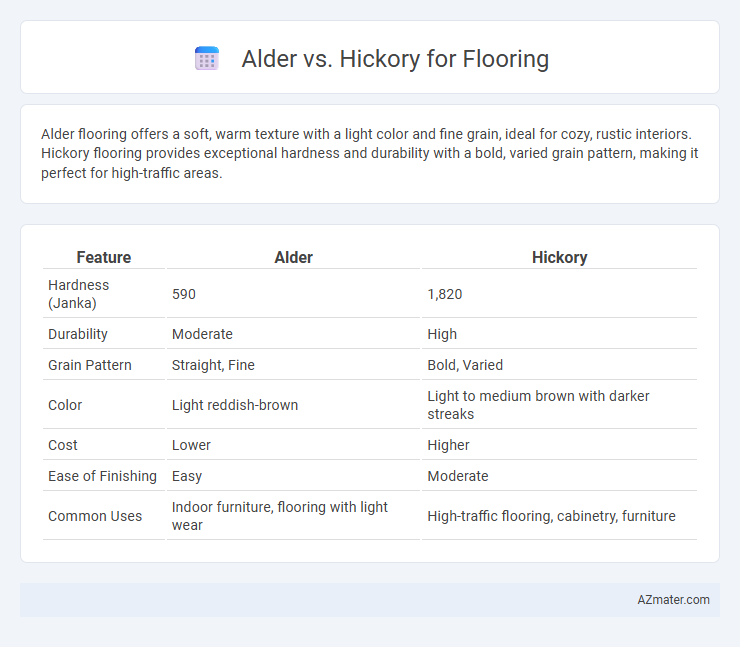Alder flooring offers a soft, warm texture with a light color and fine grain, ideal for cozy, rustic interiors. Hickory flooring provides exceptional hardness and durability with a bold, varied grain pattern, making it perfect for high-traffic areas.
Table of Comparison
| Feature | Alder | Hickory |
|---|---|---|
| Hardness (Janka) | 590 | 1,820 |
| Durability | Moderate | High |
| Grain Pattern | Straight, Fine | Bold, Varied |
| Color | Light reddish-brown | Light to medium brown with darker streaks |
| Cost | Lower | Higher |
| Ease of Finishing | Easy | Moderate |
| Common Uses | Indoor furniture, flooring with light wear | High-traffic flooring, cabinetry, furniture |
Introduction to Alder and Hickory Flooring
Alder flooring offers a warm, reddish-brown hue with a smooth texture, making it ideal for rustic and casual interior designs. Hickory flooring stands out for its exceptional hardness and durability, featuring a bold grain pattern with varying color tones from light to dark brown. Both woods provide unique aesthetic and functional benefits, with alder being softer and easier to work with, while hickory delivers superior wear resistance for high-traffic areas.
Appearance and Grain Patterns
Alder flooring features a smooth texture with consistent grain patterns and a warm, reddish-brown hue that darkens over time, creating a cozy and inviting atmosphere. Hickory displays a more pronounced, varied grain with distinct knots and color variations ranging from cream to rich brown, offering a rustic and dynamic look. Both hardwoods provide unique aesthetic appeal, with alder suited for softer, uniform designs and hickory ideal for bold, natural character in flooring.
Durability and Hardness Comparison
Alder wood, with a Janka hardness rating of approximately 590, offers moderate durability but is softer and more prone to dents and scratches compared to Hickory, which has a significantly higher Janka rating of around 1820. Hickory's superior hardness makes it one of the most durable hardwoods for flooring, ideal for high-traffic areas requiring resistance to wear and impact. Selecting Hickory over Alder ensures enhanced longevity and minimal maintenance in flooring applications due to its robust strength and resilience.
Cost and Affordability
Alder flooring typically costs between $3 to $5 per square foot, making it a more affordable option compared to Hickory, which ranges from $5 to $9 per square foot. Alder's softer texture and lower price point appeal to budget-conscious homeowners seeking a warm, natural look without sacrificing style. Hickory's higher cost reflects its increased durability and hardness, ideal for high-traffic areas where long-term wear resistance is crucial.
Installation Process Differences
Alder flooring features a softer wood grain, making it easier to cut and install with common tools, while hickory's dense and hard texture requires specialized blades and more effort during sanding and nailing. Alder's uniformity allows for faster fitting and fewer adjustments, whereas hickory's natural hardness often demands pre-drilling to prevent splitting and longer acclimation periods to adjust to humidity changes. Choosing between alder and hickory affects installation time and labor intensity due to their distinct hardness levels and grain patterns.
Maintenance and Care Requirements
Alder flooring requires gentle cleaning with pH-neutral products to maintain its soft, warm tones and is more susceptible to dents and scratches due to its lower hardness rating of 590 on the Janka scale. Hickory flooring, rated at 1820 on the Janka scale, demands more robust maintenance efforts but offers superior durability and resistance to wear, making it ideal for high-traffic areas. Proper conditioning and regular sweeping help preserve alder's finish, while hickory benefits from occasional refinishing and moisture control to prevent warping and maintain its strong grain pattern.
Environmental Impact and Sustainability
Alder flooring offers a lower environmental impact due to its faster growth rate and higher availability compared to hickory, promoting sustainable harvesting practices. Hickory, while denser and more durable, requires longer growth periods, which can contribute to greater deforestation concerns if not sourced responsibly. Both woods can be sustainable choices when obtained from certified forests following eco-friendly forestry management standards such as FSC certification.
Finishing Options and Customization
Alder flooring offers a wide range of finishing options including stains, paints, and clear coats that enhance its smooth, fine grain and warm tones, making it highly customizable for various interior styles. Hickory flooring features a denser, more rugged grain that accepts stains well, allowing for both rustic and contemporary finishes, with customization options including distressed looks and hand-scraped textures. Both wood types can be factory finished or site finished to achieve specific sheens and colors, but hickory's durability often makes it a preferred choice for high-traffic areas requiring tougher finishes.
Best Use Cases for Each Wood
Alder flooring offers a warm, rustic appearance ideal for residential spaces like living rooms and bedrooms where a softer, lighter wood enhances comfort and aesthetic appeal. Hickory, known for its exceptional hardness and durability, suits high-traffic areas such as kitchens, hallways, and commercial settings requiring resilience against dents and wear. Both woods provide distinct grain patterns and color variations, allowing homeowners to match flooring choices with specific interior design themes and functional needs.
Choosing Between Alder and Hickory for Your Home
Alder flooring offers a warm, smooth texture with a fine grain, making it ideal for creating a cozy, rustic atmosphere, while hickory provides exceptional durability and a striking contrast of light and dark tones that withstands heavy foot traffic and high wear. Choosing between alder and hickory depends on desired aesthetics and durability needs: alder suits softer, quieter spaces, whereas hickory excels in high-traffic areas requiring toughness and longevity. Both hardwood options bring unique character to homes but selecting the right species enhances flooring performance and complements interior design styles effectively.

Infographic: Alder vs Hickory for Flooring
 azmater.com
azmater.com